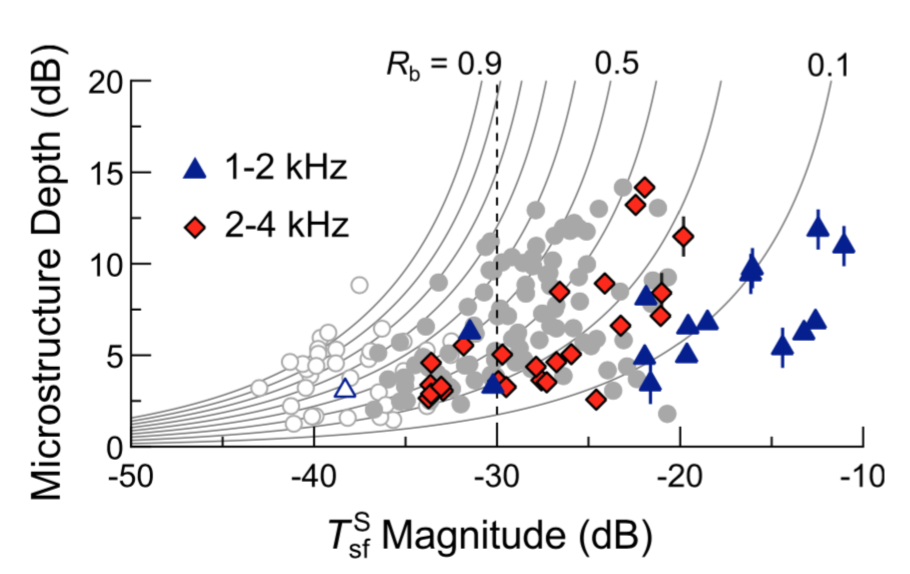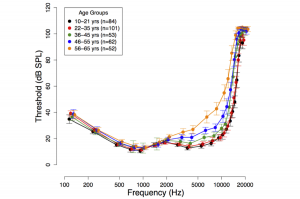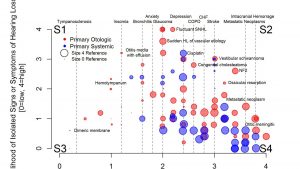Research
BibCat
BibCat is our internal library of papers we have read.
CEDRA
The Consumer Ear Disease Risk Assessment is a questionnaire to be used by seekers of hearing aids. The questionnaire gives you a risk score to help you determine whether you should see a physician or audiologist before purchasing hearing aids to rule out other ear diseases.
Cochlear Mechanics and OAEs

Otoacoustic emissions (OAEs) provide a convenient noninvasive window into cochlear mechanics. OAEs also provide a tool that can be applied uniformly across species to explore and understand commonalities and differences. Finally, OAEs are ideally suited for clinical applications across all ages. Our study of OAEs as a window into cochlear mechanics forms the foundation upon which we build our applied research enterprise. In this specific area we are interested in how OAEs are generated and how they propagate out from the cochlea to the outer ear. We have investigated the origin of what has become known as cochlear fine structure or microstructure. The ultimate goal is to understand the normal function of the cochlea and then apply this knowledge to build accurate and sensitive clinical tools for detection of cochlear malfunction.
Funded by NIH/NIDCD; ASHA Foundation; Knowles Hearing Center; American Hearing Research Foundation
- Glavin, CC, Dhar, S(2025)The Ins and Outs of Distortion Product Otoacoustic Emission Growth: A Review. J Assoc Res Otolaryngol 26 (1):17-32.
- Glavin, CC, Dhar, S, Goodman, SS(2023)Measurement of swept level distortion product otoacoustic emission growth functions at multiple frequencies simultaneously. JASA Express Lett 3 (6):.
- Glavin, CC, Siegel, J, Dhar, S(2021)Distortion Product Otoacoustic Emission (DPOAE) Growth in Aging Ears with Clinically Normal Behavioral Thresholds. J Assoc Res Otolaryngol 22 (6):659-680.
Hearing Across the Lifespan

From before birth through every day of our lives, we count on our acute sense of hearing for life-critical functions. In this line of work we study the maturation and aging of hearing through the human lifespan. In particular we are interested in the changes in inner ear (cochlea) function. Over the last few years we have collaborated with developmental scientist Carolina Abdala (University of Souther California) to study the maturation of inner ear function in premature and term infants. In another collaboration with Northwestern colleague Jonathan Siegel, we have evaluated changes in inner ear function during middle age. While this major focus in our laboratory continues to reveal interesting new knowledge, we have already demonstrated remarkable changes in inner ear function much earlier in life than previously known. Our results seem to suggest that the human inner ear starts to show signs of age-related changes as early as the third decade of life and these changes accelerate in the next twenty years.
This work has profound implications on when and how to deliver hearing health care. These findings also shed new light on the timeline of auditory aging.
- Poling, GL, Siegel, JH, Lee, J, Dhar, S(2022)The influence of self-reported noise exposure on 2ƒ1-ƒ2 distortion product otoacoustic emission level, fine structure, and components in a normal-hearing population. J Acoust Soc Am 151 (4):2391.
- Glavin, CC, Siegel, J, Dhar, S(2021)Distortion Product Otoacoustic Emission (DPOAE) Growth in Aging Ears with Clinically Normal Behavioral Thresholds. J Assoc Res Otolaryngol 22 (6):659-680.
- Cornwell, T et al.(2020)Walking With Ears: Altered Auditory Feedback Impacts Gait Step Length in Older Adults. Front Sports Act Living 2 :38.
Hearing Healthcare

Hearing loss is incredibly prevalent, with one-in-three adults over the age of 65 suffering from disabling hearing loss, and even larger numbers experiencing mild or moderate loss. Along with collaborators at Northwestern University, University of Texas and the Mayo Clinic we are investigating health care for this growing population of individuals with hearing loss. We are seeking to improve access to care by removing barriers to entry, such as the medical waiver needed to purchase a hearing aid. Furthermore, we are developing research that will address the gaps in knowledge about hearing health care, focusing particularly on unrecognized barriers to care and the costs associated with the ongoing epidemic of hearing loss.
Funded by NIH/NIDCD
- Klyn, NAM, Letendre, C, Shrestha, N, Lambert, BL, Dhar, S(2021)Interpretability of the audiogram by audiologists and physician non-specialists. Int J Audiol 60 (2):133-139.
- Klyn, NAM et al.(2019)CEDRA: A Tool to Help Consumers Assess Risk for Ear Disease. Ear Hear 40 (6):1261-1266.
- Kleindienst, SJ et al.(2018)Errors in Items and Algorithm in Questionnaire Used in Validation Study. JAMA Otolaryngol Head Neck Surg 144 (5):462.
- Klyn, NAM et al.(2018)A Retrospective Estimate of Ear Disease Detection Using the "Red Flags" in a Clinical Sample. Ear Hear 39 (5):1035-1038.
- Kleindienst, SJ et al.(2017)Development and Initial Validation of a Consumer Questionnaire to Predict the Presence of Ear Disease. JAMA Otolaryngol Head Neck Surg 143 (10):983-989.
- Kleindienst, SJ et al.(2016)Identifying and Prioritizing Diseases Important for Detection in Adult Hearing Health Care. Am J Audiol 25 (3):224-31.
